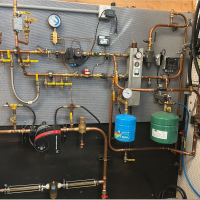Thinwall plastic pipe identification
Can anyone help id this pipe material? 4” plastic and sized to fit nds pvc sewer and drain fittings (schedule 20, 35 etc). This was pulled from an underground downspout extension which was leaking. I would have just assumed its PVC except for the black interior.
I’m a DIY homeowner so forgive my ignorance.
I need to know if typical pvc solvent weld is right to glue to the stub still in the ground or if not, what to do in the case its HDPE or something else.
Comments
-
From your picture that looks like schedule 10 pipe. It is commonly used for down spout drainage as pictured. Your hardware store will have fittings and pipe that will connect it. As for glueing the pipe. Many do not glue it as it is underground and will seep water there without concern. If you must glue it (I rarely have, and most I have seen is not) a common PVC primer and glue should be fine.
1 -
thanks. What was there was indeed unglued and seeping. I dug it up as ive been having a lot of water issues in the basement right at that spot. I don’t think gluing this joint will fully solve the problem but it might be a contributing factor, so better to seal it up.
0 -
Try if you can leaving the horizontal exposed on the ground, rather than buried drawing the water away from foundation. It's something that I have done. Works nicely.
0 -
it might be a HDPE pipe like you see in the home centers. ADS is the brand I see around here. Irrigation and storm water drainage mainly.
Bob "hot rod" Rohr
trainer for Caleffi NA
Living the hydronic dream0 -
if i test a standard glue/fitting on the sample i dug up and it seems solid after a couple hours, I am good to go right?
@hot_rod - it doesn’t have the corrugated build of the screenshots from ADS. Ive seen that pipe in the box stores as well0 -
-
-
Agreed. This is one of the reasons I suggested not to bury the pipe but put it above ground. This helps especially when the ground hasn't thawed and will not absorb the water well due to the frost.
0 -
@mattmia2 - agreed this probably won’t fix the problem. I dug it up wondering if something was cracked causing the water in the basement. It wasn’t (of course I cracked the old fitting as I dug!).
I’m really not sure where the water is coming from but as long as I have this exposed its better going on there glued and sealed than loose and a bit leaky
0 -
the outgoing pipe is already buried. I dug up enough to expose and reattach the downspout to the buried stub. I hear what you’re saying about having a surface pipe to collect groundwater and divert it away but the landscape doesn’t accommodate. Its a smallish space penned in by walkways.
0 -
-
already done and it passed the test
0 -
I’ve worked with that type; outer is standard pvc with a bonded PE inner layer. No idea why or the advantage over standard schedule 10. I’ve only used when HD was out of the standard.
0 -
i tested standard pvc glue on it tonight. Seemed to bond perfectly well with the fitting. Will get it back together in the next day or two
0 -
Categories
- All Categories
- 87.3K THE MAIN WALL
- 3.2K A-C, Heat Pumps & Refrigeration
- 61 Biomass
- 427 Carbon Monoxide Awareness
- 119 Chimneys & Flues
- 2.1K Domestic Hot Water
- 5.8K Gas Heating
- 115 Geothermal
- 165 Indoor-Air Quality
- 3.7K Oil Heating
- 76 Pipe Deterioration
- 1K Plumbing
- 6.5K Radiant Heating
- 395 Solar
- 15.6K Strictly Steam
- 3.4K Thermostats and Controls
- 56 Water Quality
- 51 Industry Classes
- 49 Job Opportunities
- 18 Recall Announcements





